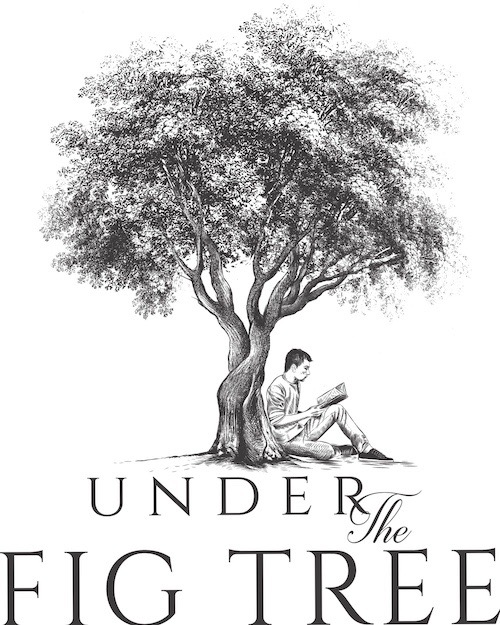‘Under the fig tree’ is an ancient Jewish idiom or colloquialism which is symbolic of the age of the Messiah and peace:
“‘I saw you while you were still under the fig tree’ … refers to life and study of Torah in the millennium…The millennial concept of the fig tree is found throughout the Tanakh…” (Signs in the Heavens, Avi ben Mordechai, pp. 295-6)
Where do we see the concept of the fig tree throughout the Tanakh? Since the third chapter of Genesis, when Adam and Eve sewed coverings from the leaves of their fig tree (Gen 3:7) the fig tree was a staple part of the ancient world’s garden (see also Deut 8:8 and Psalm 105:33). But it was during King Solomon’s reign, that the concept of the fig tree began to signify a place of peace: “And Judah and Israel dwelt safely, each man under his vine and his fig tree, from Dan as far as Beersheba, all the days of Solomon.” (1 Kings 4:25) When we come to the section of the Prophets, the concept of the fig tree within a Messianic context really takes off:
Micah 4:2-5
Nation shall not lift up sword against nation,
Neither shall they learn war anymore.
But everyone shall sit under his vine and under his fig tree,
And no one shall make them afraid;
For the mouth of the LORD of hosts has spoken.
For all people walk each in the name of his god,
But we will walk in the name of the LORD our God
Forever and ever.”
Zechariah 3:9-10
For behold, the stone
That I have laid before Joshua:
Upon the stone are seven eyes.
Behold, I will engrave its inscription,’
Says the LORD of hosts,
‘And I will remove the iniquity of that land in one day.
In that day,’ says the LORD of hosts,
‘Everyone will invite his neighbor
Under his vine and under his fig tree.’ ”
With all this in the back of your minds, now let’s jump forward to the time of Yeshua (Jesus). Yeshua used the well known fig tree in his teachings about faith and about fruitfulness (Matt 21:19, Matt 24:32; Mark 11:30; Luke 13:6). But he also used it to give us extra insight into what was so special about the concept of the fig tree:
“Philip found Nathanael and said to him, “We have found Him of whom Moses in the law, and also the prophets, wrote—Jesus of Nazareth, the son of Joseph.” And Nathanael said to him, “Can anything good come out of Nazareth?” Philip said to him, “Come and see.” Jesus saw Nathanael coming toward Him, and said of him, “Behold, an Israelite indeed, in whom is no deceit!” “Nathanael said to Him, “How do You know me?” Jesus answered and said to him, “Before Philip called you, when you were under the fig tree, I saw you.” Nathanael answered and said to Him, “Rabbi, You are the Son of God! You are the King of Israel!” Jesus answered and said to him, “Because I said to you, ‘I saw you under the fig tree,’ do you believe? You will see greater things than these.”” (John 1:45-50)
From the start we learn about Messianic prophecy. Phillip says: We found the Messiah that Moses and the prophets prophesied about all throughout scripture! Then Nathanel asks: Can anything good come from Nazareth? Nazareth in Hebrew is Nazrat and comes from the word netzer which means branch. Isaiah made it clear hundreds of years earlier that this ‘Branch’ will be the promised Messiah: “There shall come forth a Rod from the stem of Jesse, and a Branch shall grow out of his roots” (Isaiah 11:1). Zechariah also talks of the Branch: “For behold I am bringing forth My Servant the BRANCH” (Zech 3:8). But let’s look at what happens next. As Nathanel approaches Yeshua, He (Yeshua) tells him: I saw you already, under the fig tree. What made Nathanel declare such a response: “Rabbi (Teacher), you are the Son of God! You are the King of Israel!” As indeed, the fig tree was a common part of the landscape and each man’s land, what was it about the fact that Yeshua saw him under the fig tree that got Nathanel so excited? You see the idiom ‘under the fig tree’ was not only an idiom for each family being able to dwell under their own trees in peace and safety, but it became a colloquialism for ancient man’s study of the Messiah and the peace He will bring with Him.
When Yeshua told Nathanel, ‘I saw you under the fig tree,’ He wasn’t necessarily saying that He saw him sitting literally under his tree; He was telling him: ‘I know you have been diligently seeking the Messiah’. At that point I believe the Holy Spirit revealed to Nathanel that this was He whom he had been seeking all his life.
There is coming a day in the land when the blindness that has been cast upon the majority of Jewish people by the Holy Spirit (Romans 11:25) will be stripped away and the minority who do believe, will invite their neighbors to come and sit ‘under their fig trees’ to come and hear the message of the Gospel and to learn about their Jewish Messiah. Faith and salvation for the Jewish people will come by hearing the Gospel: “How then will they call on Him in whom they have not believed? How will they believe in Him whom they have not heard? And how will they hear without a preacher? How will they preach unless they are sent? Just as it is written, “How beautiful are the feet of those who bring good news of good things!” (Romans 10:14-17)
Yeshua said in Matthew 9:37-38, “The harvest is plentiful, but the workers are few. “Therefore beseech the Lord of the harvest to send out workers into His harvest.” The entire Jewish nation is not going to come to faith through one preacher. It is going to take thousands. The work that we are doing today is to find and raise up those workers.
One day, all of Israel will be saved (Rom 11:26). We believe that on that day when God pours out His spirit of grace and supplication on the land (Zechariah 12:10-14), the followers of Yeshua here in Israel are going to invite their neighbors ‘under their fig trees’ – to study about the Messiah – and we will see a national repentance to God. This is the time that we are preparing for and the vision for our ministry here. We invite each and every one of you to join us and be a part in prayer, in fasting and support.




